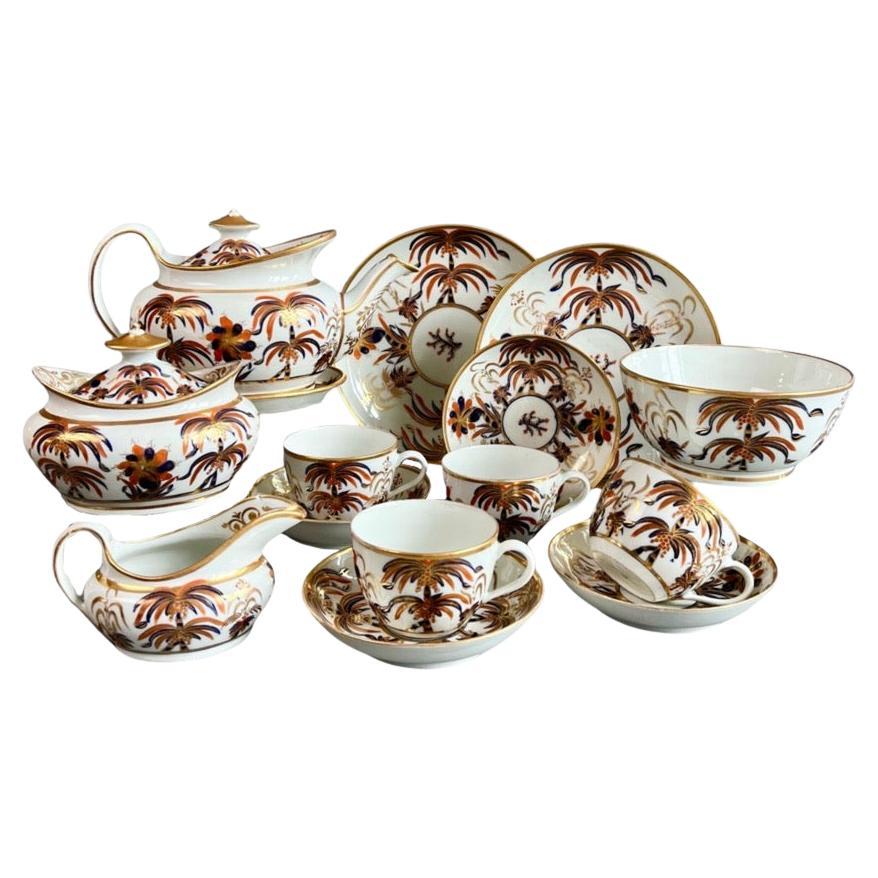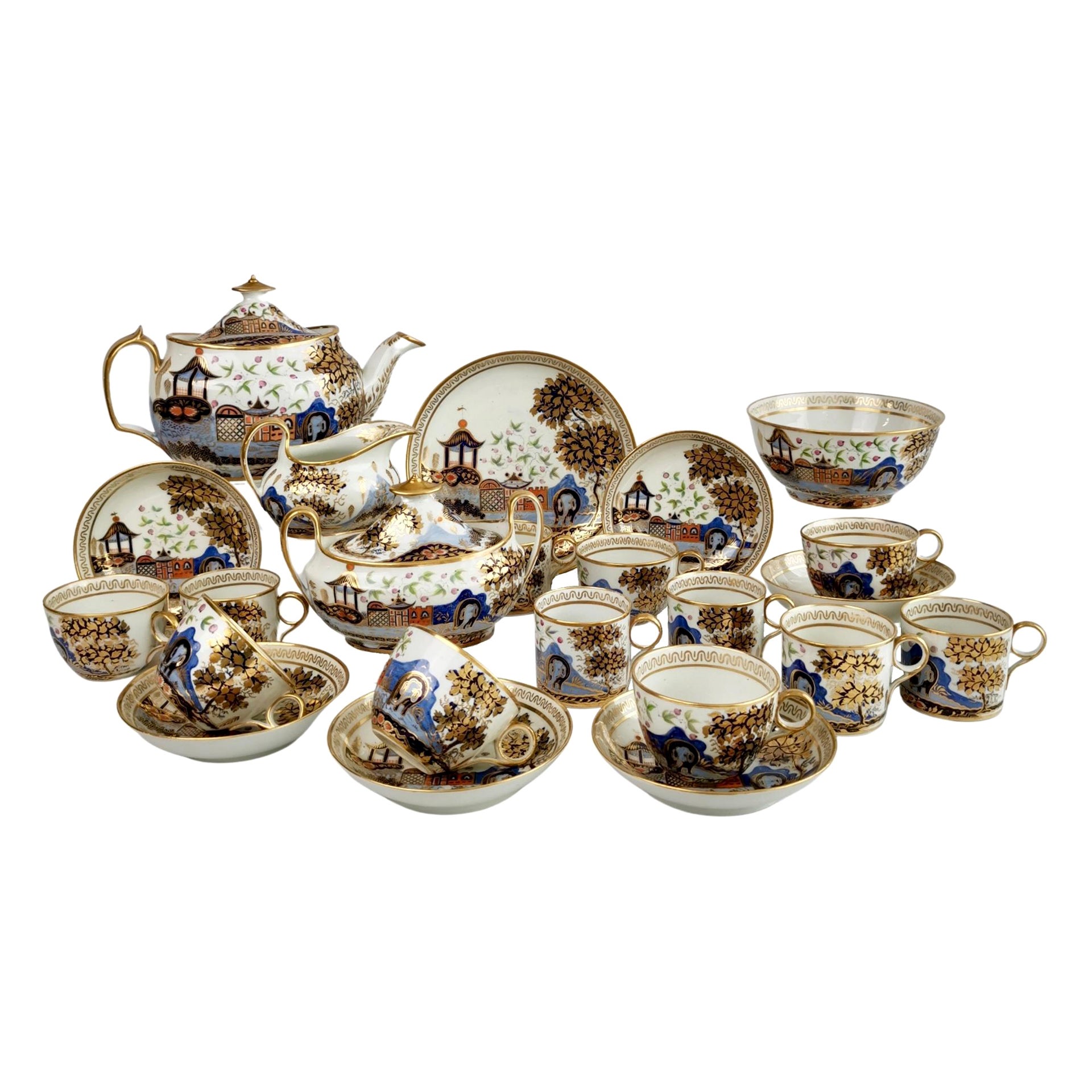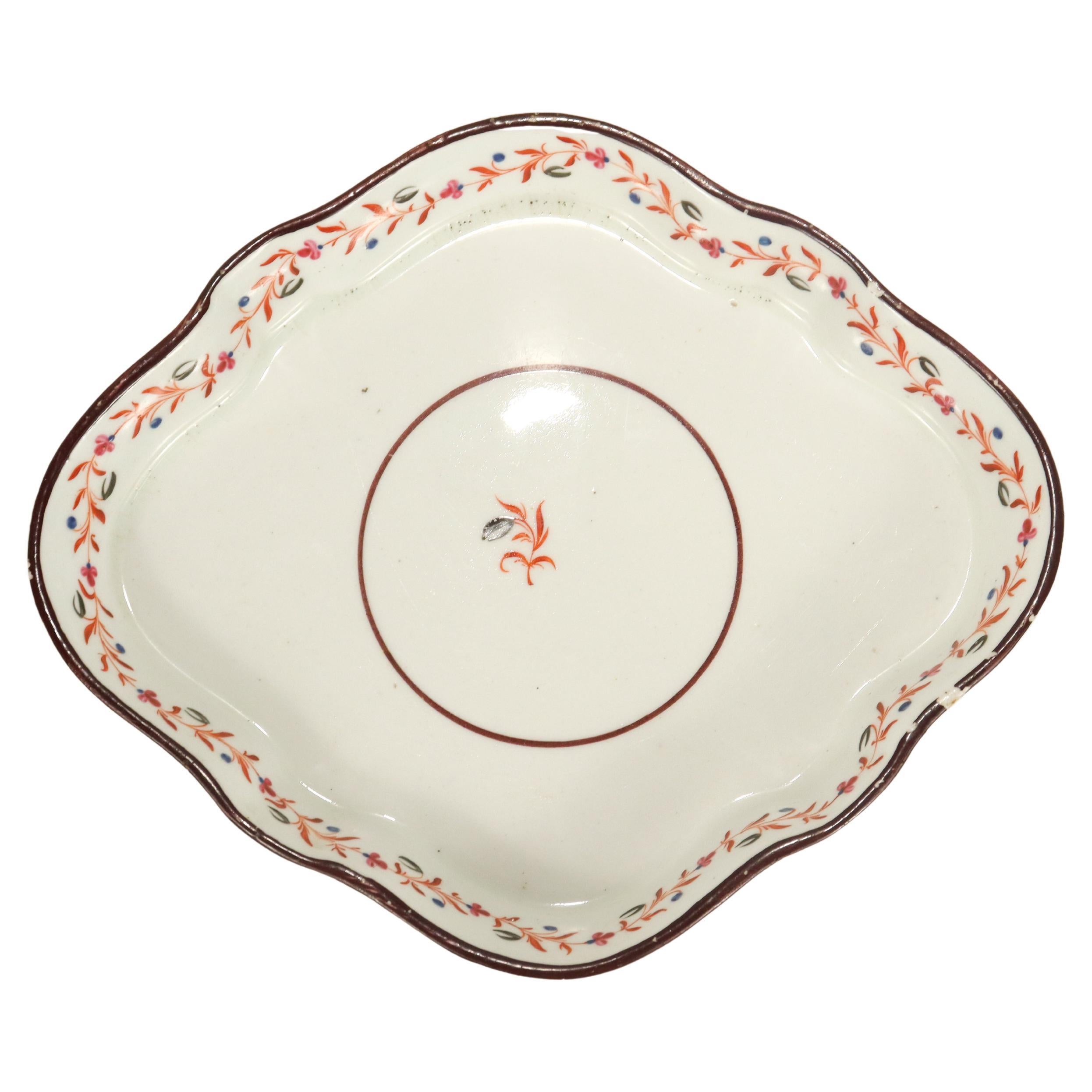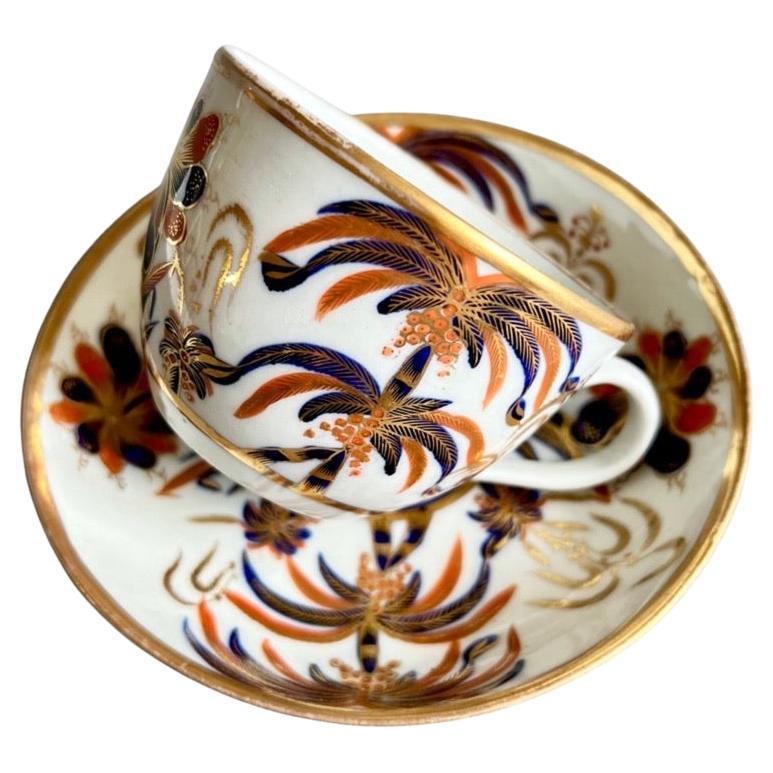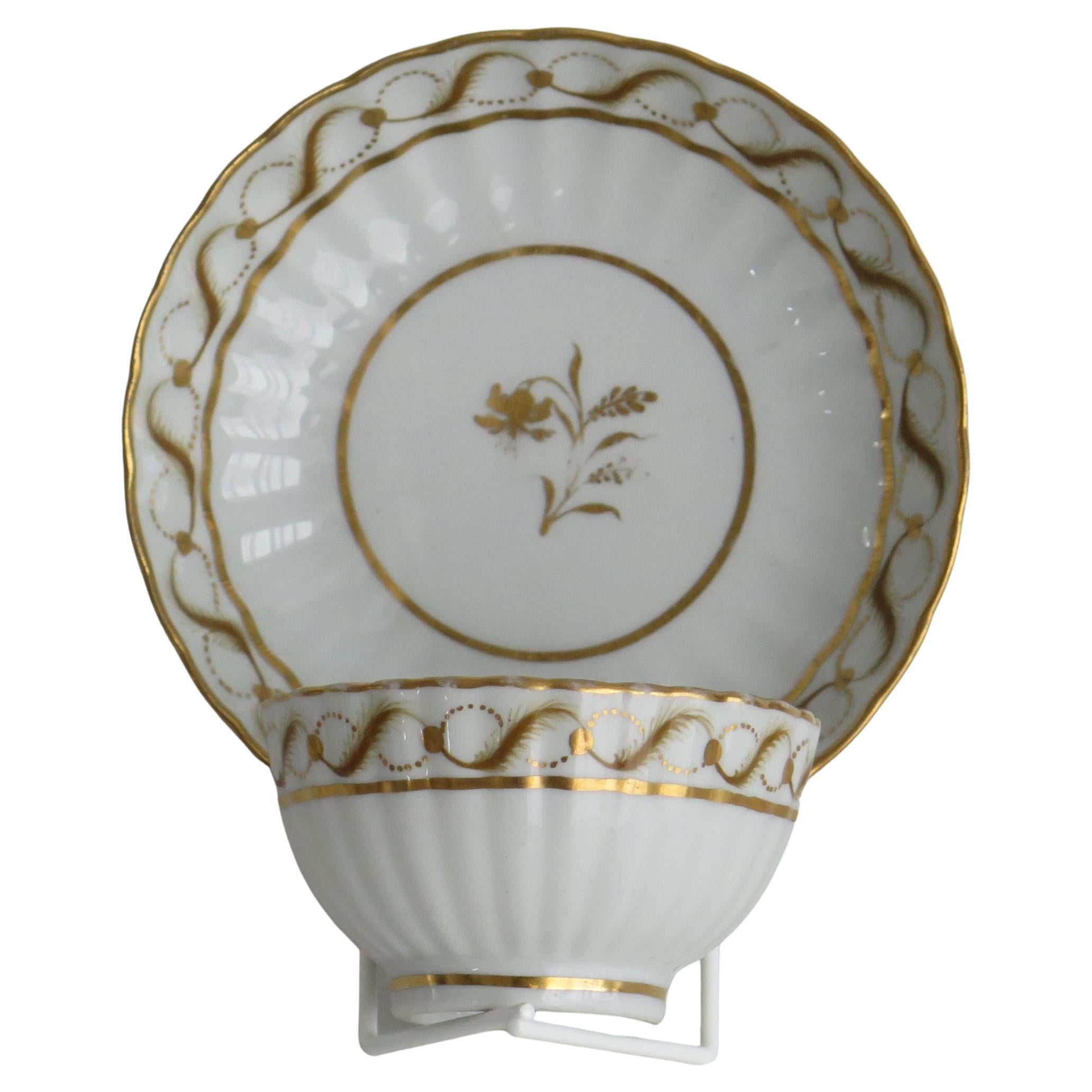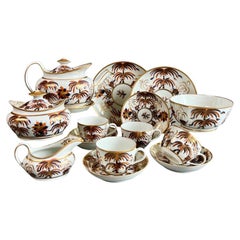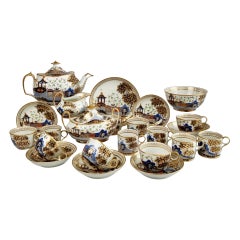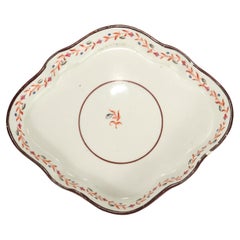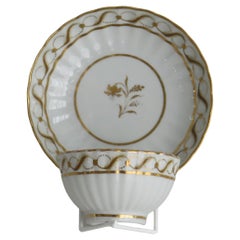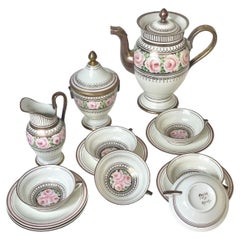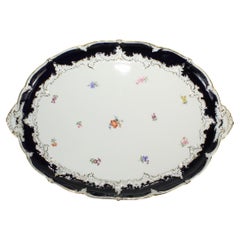Items Similar to New Hall Porcelain Tea Service, Chinoiserie Flower Sprays, Georgian, circa 1795
Want more images or videos?
Request additional images or videos from the seller
1 of 21
New Hall Porcelain Tea Service, Chinoiserie Flower Sprays, Georgian, circa 1795
About the Item
This is a stunning tea service made by New Hall in circa 1795. The service is made of hybrid hard paste porcelain and decorated in a bold Chinoiserie pattern of large flower sprays. The service consists of a teapot with cover, a milk jug, a slop bowl, and six tea bowls with saucers.
This service has provenance; it came from the collection of David Redstone, the well known porcelain expert who wrote leading books on Bow and Chelsea porcelain.
The New Hall factory started as a cooperative of several Staffordshire potters making use of the porcelain license of Bristol Porcelain Company after this went in demise. It quickly grew out to be a leading porcelain maker, and the first to make true porcelain in Staffordshire.
This set is made in the typical "hybrid hard paste" porcelain, as New Hall had adapted the original hard paste recipe from Bristol in order to save on production costs. You can tell this by the way the porcelain has a blue hue and is less milky than bone china. As this hybrid porcelain was slightly cheaper to make and very popular among customers who were used to the more stony Chinese Export porcelain, New Hall was a late adapter of bone china, which was already used by most other factories around the time this set was made. This type of porcelain was very good for the "Chinoiserie" decorations.
The teapot is shaped in what is called the "commode" shape; a nicely paneled shape that was popular in the 1790s. The cups are still bowls; in the late 18th century many people still preferred to drink tea from bowls in the Chinese manner and of course they stack much better. The decoration consists of a bold pattern of large flower sprays in the Chinese manner, in orange, green, blue and fuchsia pink. The colors are a daring combination; the orange and pink make a wonderful clash, held together by the bright blue colour. In the late 18th and early 19th century English factories copied Chinese patterns to satisfy the need for replacements of broken Chinese items, and also because English customers only gradually got used to more Western designs and many still preferred the blueish old style porcelain (rather than bone china) and the "Chinoiserie" designs of the 18th century Chinese imports.
The items are unmarked, as is customary for New Hall, but teapot, jug and bowl are marked with the pattern number 272.
Condition report: The service is in perfect condition except one flaw: there is a crack in the tip of the teapot spout (see last picture); however it is still suitable for use. Other than this there is absolutely no damage, repairs, crazing or even wear.
Antique British porcelain is never perfect. Kilns were fired on coal in the 1700s, and this meant that china from that period can have some firing specks from flying particles. British makers were also known for their experimentation, and sometimes this resulted in technically imperfect results. Due to the shrinkage in the kiln, items can have small firing lines or develop crazing over time, which should not be seen as damage but as an imperfection of the maker's recipes, probably unknown at the time of making. Items have often been used for many years and can have normal signs of wear, and gilt can have signs of slight disintegration even if never handled. I will reflect any damage, repairs, obvious stress marks, crazing or heavy wear in the item description but some minor scratches, nicks, stains and gilt disintegration can be normal for vintage items and need to be taken into account.
There is widespread confusion on the internet about the difference between chips and nicks, or hairlines and cracks. I will reflect any damage as truthfully as I can, i.e. a nick is a tiny bit of damage smaller than 1mm and a chip is something you can easily see with the eye; a glazing line is a break in the glazing only; hairline is extremely tight and/or superficial and not picked up by the finger; and a crack is obvious both to the eye and the finger.
Dimensions to be added.
- Creator:New Hall (Maker)
- Dimensions:Height: 1 in (2.54 cm)Width: 1 in (2.54 cm)Depth: 1 in (2.54 cm)
- Sold As:Set of 16
- Style:George III (Of the Period)
- Materials and Techniques:
- Place of Origin:
- Period:1790-1799
- Date of Manufacture:circa 1795
- Condition:Wear consistent with age and use. In excellent antique condition.
- Seller Location:London, GB
- Reference Number:Seller: A-NEW231stDibs: LU4805122045592
About the Seller
5.0
Gold Seller
These expertly vetted sellers are highly rated and consistently exceed customer expectations.
Established in 2016
1stDibs seller since 2019
214 sales on 1stDibs
Typical response time: 2 hours
- ShippingRetrieving quote...Ships From: London, United Kingdom
- Return PolicyA return for this item may be initiated within 14 days of delivery.
Authenticity Guarantee
In the unlikely event there’s an issue with an item’s authenticity, contact us within 1 year for a full refund. DetailsMoney-Back Guarantee
If your item is not as described, is damaged in transit, or does not arrive, contact us within 7 days for a full refund. Details24-Hour Cancellation
You have a 24-hour grace period in which to reconsider your purchase, with no questions asked.Vetted Professional Sellers
Our world-class sellers must adhere to strict standards for service and quality, maintaining the integrity of our listings.Price-Match Guarantee
If you find that a seller listed the same item for a lower price elsewhere, we’ll match it.Trusted Global Delivery
Our best-in-class carrier network provides specialized shipping options worldwide, including custom delivery.More From This Seller
View AllNew Hall Hybrid Hard Paste Porcelain Tea Service, Palm Tree patt. 484, ca 1810
By New Hall
Located in London, GB
This is a spectacular 17-piece tea service serving four, made by New Hall around the year 1810. The service consists of a teapot with cover on a stand, a sucrier with cover, a milk j...
Category
Antique 1810s English Georgian Porcelain
Materials
Porcelain
$4,150 / set
Free Shipping
Chamberlains Worcester Orphaned Coffee Cup, Sepia Flower Sprays, Georgian ca1795
By Chamberlains Worcester
Located in London, GB
This is a beautiful orphaned coffee cup made by Chamberlains Worcester in about 1795. The cup has a spirally fluted or shanked shape and is decorated...
Category
Antique 1790s English George III Tea Sets
Materials
Porcelain
New Hall Tea Service for Four, Elephant Pattern 876, Regency ca 1810
By New Hall
Located in London, GB
PLEASE NOTE THE NUMBER OF TRIOS IN THIS SERVICE HAS BEEN REDUCED FROM SIX TO FOUR, AND THE PRICE HAS BEEN REDUCED ACCORDINGLY. IT NOW IS AN 18-PIECE SERVICE.
This is spectacular full tea service for four made by New Hall around the year 1810. The service consists of a teapot with cover, a sucrier with cover, a milk jug, four trios each consisting of a teacup, a coffee can and a saucer, a cake plate (saucer dish) and a slop bowl. The set is decorated in the super-charming and popular but very rare Elephant pattern...
Category
Antique 1810s English Regency Tea Sets
Materials
Porcelain
New Hall Hybrid Hard Paste Teacup, Palm Tree patt. 484, Georgian ca 1810
By New Hall
Located in London, GB
This is a beautiful teacup and saucer made by New Hall around the year 1810. The set is decorated in the very desired but rare palm tree pattern with the number 484.
We also have a ...
Category
Antique 1810s English Regency Tea Sets
Materials
Porcelain
Derby Porcelain Tea Service, Artichoke Pattern in Turquoise, ca 1785
By Derby
Located in London, GB
This is a beautiful and extremely rare tea service made by Derby in about 1785. The set has the distinctive "artichoke" moulding and a bright turquoise ground with the white artichok...
Category
Antique 1780s English George III Tea Sets
Materials
Porcelain
Derby Porcelain Tea Bowl, Artichoke Pattern in Turquoise, Georgian ca 1785
By Derby
Located in London, GB
This is a beautiful tea bowl and saucer made by Derby in about 1785. The set has the distinctive "artichoke" moulding and a bright turquoise ground with the white artichoke surface ...
Category
Antique 1780s English George III Tea Sets
Materials
Porcelain
You May Also Like
Antique English Shaped New Hall Porcelain Teapot Trivet
By New Hall
Located in Philadelphia, PA
A fine antique English porcelain teapot trivet.
Attributed to New Hall.
In a diamond-shaped form.
With a single red & black...
Category
Antique 18th Century English Georgian Porcelain
Materials
Porcelain
Fine Georgian New Hall Porcelain Tea Bowl & Saucer Gold Pattern 142, Circa 1785
By New Hall
Located in Lincoln, Lincolnshire
This is a very fine hard paste porcelain Tea Bowl and Saucer by New Hall, dating to the 18th century, George 111rd period, circa 1785.
Both pieces have 24 vertical flutes.
Both pie...
Category
Antique Late 18th Century English Georgian Ceramics
Materials
Porcelain
Vintage Porcelain Tea Service Set
Located in LA CIOTAT, FR
A stunning French Empire style coffee service, dating from around 1950, and comprising a coffee pot, six cups and saucers, a lidded sugar bowl and a cream jug. Crafted from white and...
Category
Mid-20th Century French Restauration Tea Sets
Materials
Porcelain
$1,200 / set
Antique Meissen Porcelain Tea Tray with Cobalt Blue Border & Spray Flowers
By Meissen Porcelain
Located in Philadelphia, PA
A fine antique porcelain tea tray or serving platter.
By Meissen.
With a scalloped rim and a rich cobalt blue border.
There are hand paint...
Category
20th Century German Tea Sets
Materials
Porcelain
German Meissen 'Marcolini' Porcelain Tea and Coffee Service, circa 1790
By Meissen Porcelain
Located in New York, NY
Comprising coffee pot, tea pot, covered cream jug, covered sugar, ten tea cups, six coffee cups, 16 saucers.
Category
Antique 1790s German Tea Sets
Materials
Porcelain
Late 18th Century Georgian English New Hall Partial Porcelain Tea Set
By New Hall
Located in Bridgeport, CT
Late 18th century Georgian English New Hall partial fine porcelain tea/china set with rose colored fish-scale border, scrolling garland and florets, circa 1781-1835. Included in this...
Category
Antique Late 18th Century English Georgian Porcelain
Materials
Porcelain
Recently Viewed
View AllMore Ways To Browse
Tea Set For One
Set Of Chinoiserie
Small Tea Set
Blue Tea Set
Antique Tea Service
Antique Porcelain Tea Sets
Antique Tea Sign
English Tea Set
Drinking Tea
Antique Silver Tea Service
Silver Tea Service Antique
Silver On Porcelain Tea Sets
Chinoiserie Dining Set
Antique Tea Service Set
Tea Cup Hand Painted
Tea Cups Blue
Green Tea Set
Antique Original Georgian Glasses Georgian Glass
